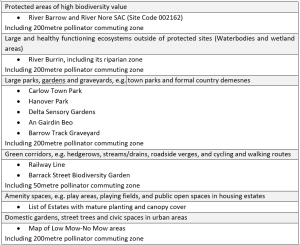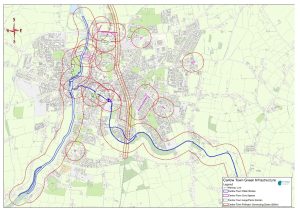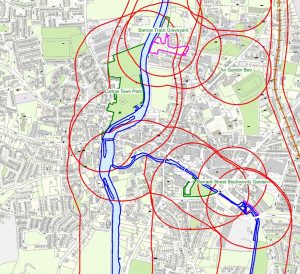Shane Casey, Environmental Awareness Officer for Carlow County Council, tells us about a new management tool for helping pollinators in urban areas.
In April, 2023, Carlow County Council adopted their County Carlow Green Infrastructure Strategy, which contained a novel approach to managing urban pollinator foraging networks. The approach is based on the policy that:
“No pollinator in County Carlow’s towns and villages will have to travel more than 200metres in order to find a food source (green space of a minimum size, that is managed for biodiversity).”
The approach resulted in the production of a pollinator foraging map (trialled in Carlow Town initially, with a view to replicating in all other towns and villages). We will expand on how this was produced, and how it can be used further below, however, there are two other key elements of the policy to be aware of:
The ‘200metres’ distance was derived from the All-Ireland Pollinator Plan’s “How Far Do Pollinators Travel” Blog, which outlines that solitary bees (the vast majority of our bee species), and many bumblebees, forage within a very short distance of their nest. It would be hoped that future iterations of the policy will reduce this distance further.
The ‘green space of a minimum size, that is managed for biodiversity’ is derived from the Carlow County Development Plan 2022 – 2028. This Plan is the parent document of the Green Infrastructure Strategy, and states that in order to qualify as Green infrastructure, ‘the ecosystem and associated environmental features must be of high quality and capable of delivering more than just green spaces (i.e. regularly mown grassed areas)’. The Plan also provides a county-wide priority hierarchy of Green Infrastructure Resources, from protected biodiversity sites at the top (e.g. Special Areas of Conservation), down to street trees and civic spaces.
Using this hierarchy, publicly managed Green Infrastructure Resources (e.g. Carlow County Council managed areas), within Carlow Town were identified as outlined below. It is anticipated that the next iteration of this list will include community managed spaces, and privately managed spaces.
In each case, a 200metre pollinator commuting zone was included. This is better visualized on Figure 1 below – essentially, the more the commuting zones overlap, the better the connectivity.


In Figure 2 below, we have zoned in of one particular area in Carlow Town to demonstrate the benefits of mapping a Pollinator Foraging Network. The commuting zones in this area form a “C” shape. Within the centre of this shape, there is a gap, despite clear green spaces on the base map. However, these areas are playing pitches, which do not qualify as priority Green Infrastructure Resources.
Mapping allows us to see the true extent of connectivity, while also allowing us to prioritise investing resources into filling the gaps, and improving connectivity, rather than expanding ‘islands’ of biodiversity.

Finally, to accompany the map, the following operational policies will apply to these areas, along with All-Ireland Pollinator Plan recommendations as applicable:
- Implement a pesticide reduction strategy in these areas, except in the case of Invasive Species control, with the aim of eliminating their use in the medium-term.
- Wherever possible, ‘No Mow’ will be the preferential management approach.
- In any area greater than 5M2, all planting must include a minimum of two canopy layers, i.e. wildflower planting can only take place when accompanied by shrub or tree planting.
- All tree planting will follow the “right tree, right place” approach, taking account of both their underground and mature canopy space requirements.
